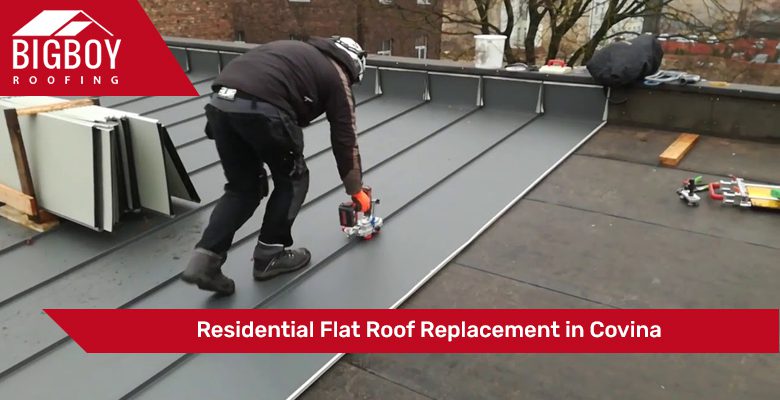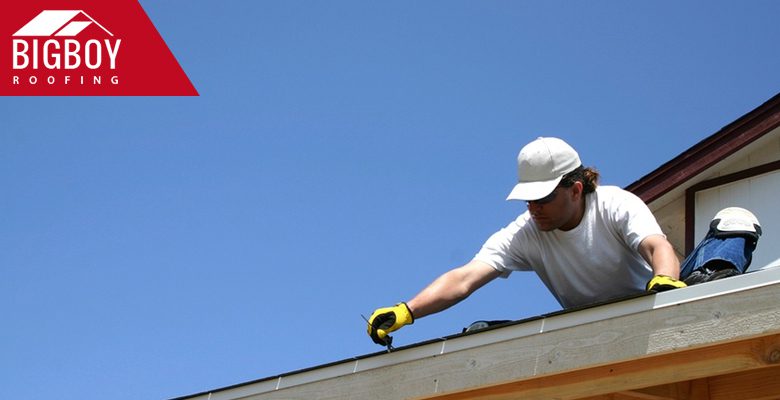Residential Flat Roof Replacement
Are you a homeowner facing the daunting task of residential flat roof replacement? We understand the challenges and concerns that come with such a project.

In this blog post, we aim to provide you with support and valuable insights on getting a residential flat roof replacement in Covina. We know how important it is to protect your home and ensure its longevity, so join us as we explore the essential steps and considerations to make this process smooth and successful.
Common Reasons for Residential Flat Roof Replacement
You may want to consider booking a roof replacement with our roofing experts for the following reasons:
I. Age and Wear: Flat roofs, like any other roofing system, have a limited lifespan. Over time, exposure to the elements, temperature fluctuations, and normal wear and tear can cause the roof to deteriorate and become less effective in protecting the structure.
II. Water Ponding: Flat roofs are more prone to water ponding when water accumulates and does not drain properly. Ponding water can cause structural damage, weaken the roof membrane, and lead to leaks and infiltration.
III. Leaks and Water Damage: If a flat roof develops leaks and allows water to penetrate the underlying layers, it can lead to significant water damage, mold growth, and compromised structural integrity.
IV. Blisters and Cracks: Exposure to sunlight, temperature changes, and poor installation can cause blisters and cracks to develop on a flat roof. These issues can compromise the roof’s ability to keep out water.
Causes of Residential Flat Roof Damage
Residential flat roofs can be prone to various types of damage due to their unique design and exposure to the elements. Here are some common causes:
| Causes | Description |
| UV radiation and heat exposure | Flat roofs are constantly exposed to the sun’s UV radiation and heat. Over time, this exposure can cause the roofing materials to deteriorate, leading to cracking, blistering, or peeling. |
| Extreme weather conditions | Severe weather events such as storms, heavy rain, snow, and hail can cause significant damage to flat roofs. Strong winds lift and dislodge roofing materials, while hail can dent or puncture the roof surface. |
| Lack of maintenance | Regular maintenance is crucial for the longevity and performance of a flat roof. Failure to perform routine inspections, cleanings, and repairs can allow minor issues to escalate into major problems. |
| Poor ventilation | Inadequate ventilation in the attic or roof space can contribute to moisture buildup, condensation, and excessive heat, all of which can impact the integrity of the flat roof. |
How Is Residential Flat Roof Replacement Done?
Residential flat roof replacement by our roofing experts typically involves several steps to ensure a successful and long-lasting installation. Here is a general outline of the process:

I. Assessment and planning: Our expert Covina roofing contractor will assess the condition of the existing flat roof and determine if a replacement is necessary. Based on the assessment, a plan for the replacement will be developed.
II. Material selection: There are various roofing materials available for flat roofs, including single-ply membranes (such as TPO or EPDM), built-up roofing (BUR) systems, modified bitumen, and others.
III. Removal of the existing roof: If a complete replacement is required, the existing roof will be removed. This involves stripping off the old roofing materials, including insulation or underlayment.
IV. Repairs and preparation: Once the old roof is removed, the contractor will inspect the underlying structure for any damage or deterioration. Any necessary repairs, such as replacing damaged decking or repairing structural issues, will be carried out.
V. Installation of underlayment and insulation: A new layer of underlayment or insulation may be installed to provide additional protection and improve energy efficiency. This layer acts as a barrier against moisture and helps regulate temperature.
VI. Installation of roofing material: The chosen roofing material will be installed according to the manufacturer’s specifications and industry best practices. This may involve rolling out and adhering single-ply membranes, applying layers of built-up roofing materials, or installing modified bitumen sheets.
Protect your home and book a roofing consultation with our roofing experts today!
Take proactive steps to safeguard your home and ensure its long-term protection. Our team of experienced roofing professionals is here to help.
FAQs
How long does a residential flat roof replacement typically take?
The duration depends on factors like the roof’s size, the project’s complexity, weather conditions, and chosen materials. Generally, it can take anywhere from a few days to weeks.
What roofing materials are suitable for flat roofs?
Common materials include single-ply membranes (TPO, EPDM), built-up roofing (BUR) systems, modified bitumen, and PVC membranes. The best choice depends on climate, budget, and durability requirements.
Will my existing roof structure need modifications for a flat roof replacement?
In some cases, modifications may be required to ensure proper installation and performance of the new flat roof. This can include repairs to the roof deck or reinforcement of the supporting structure.

